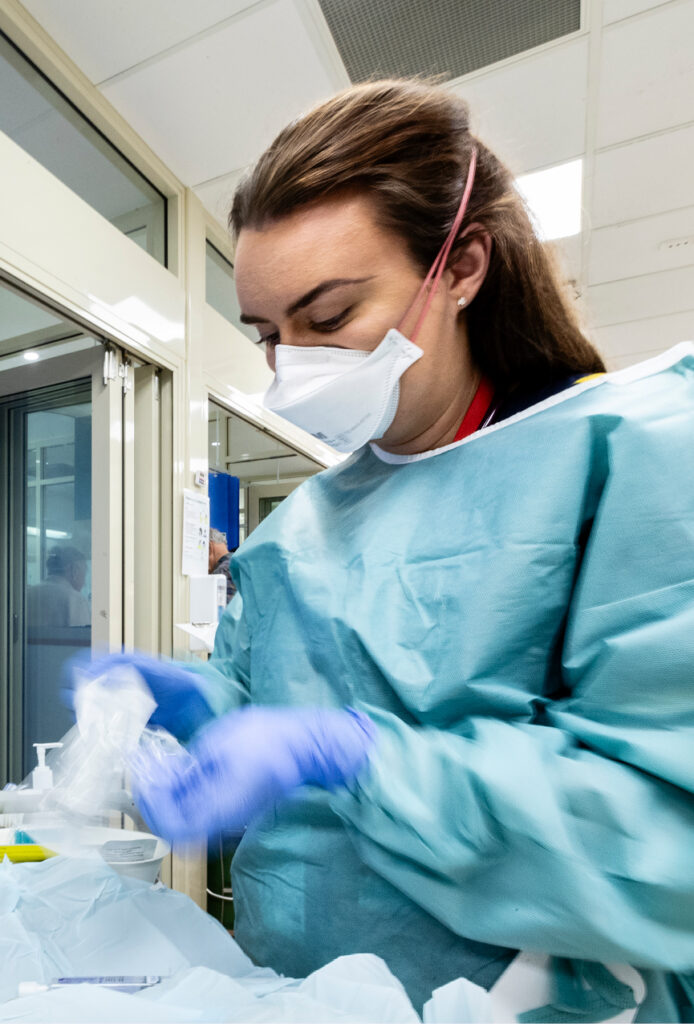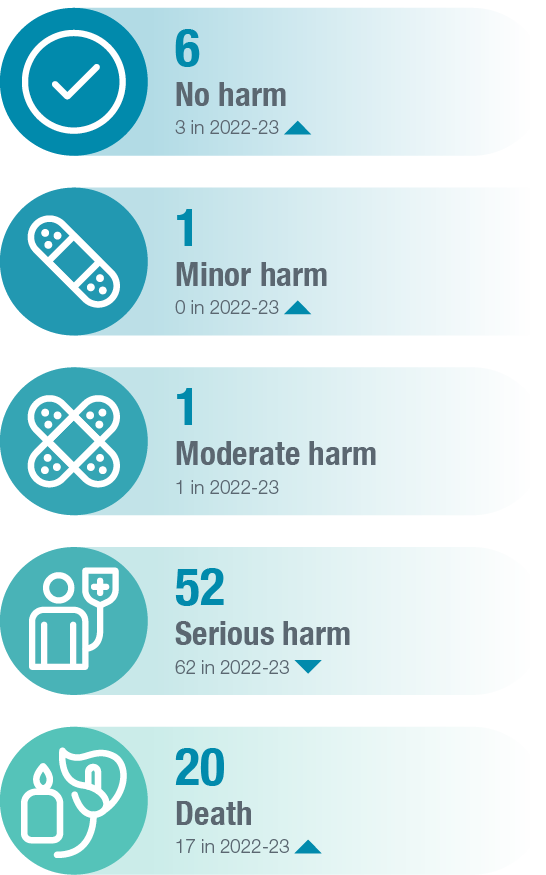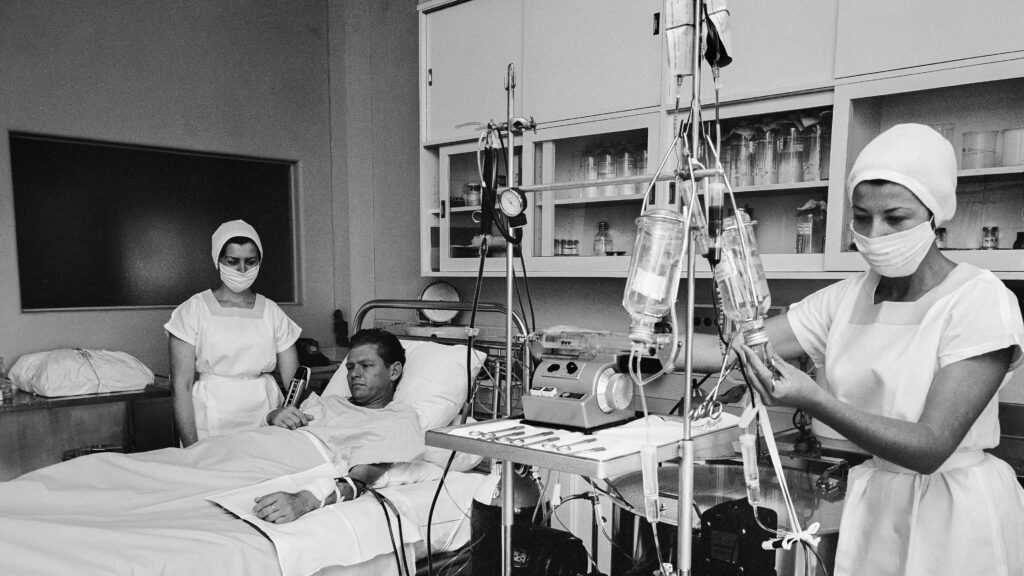The here and now
Continuing to deliver safe and high-quality care
Joining global action to shine a light on patient safety
As a symbol of our commitment to patient safety, the Royal Perth Hospital (RPH) helipad shone orange for World Patient Safety Day 2023.
The helipad was among buildings, landmarks and monuments around the world illuminated orange on 17 September 2023 to mark the World Health Organization’s annual event.
The theme for 2023 was ‘Engaging patients for patient safety’, in recognition of the role patients, families and caregivers play as partners in health care.
Partnering with patients is central to the work we do.
“At EMHS we work hard to ensure individual consumers are informed and involved in decisions and choices about their treatment,” EMHS Executive Director of Safety, Quality and Consumer Engagement, Sandra Miller, said.
“Patient safety is a shared responsibility, and together, we can make a meaningful difference in the lives of those we care for.”
We also work closely with consumer groups to co-design healthcare policies and safety interventions, so they align with patient needs and preferences.
2023-24 MySay data indicates:
From over 16,000 inpatient responses:

90 per cent of patients felt confident to ask for help

92 per cent of patients felt their views and concerns were listened to

EMHS risk management and audit functions
The ‘3 lines of defence model’ employed by EMHS defines functions that are involved and responsible for effective risk management. These lines of defence are:
- own and manage risks
- oversee risks
- provide independent assurance.
The EMHS Board Audit and Risk Committee forms part of the organisation’s wider governance framework and provides key oversight for the risk management and audit functions. Some of the key activities performed by the Board Audit and Risk Committee for this period included:
- oversight of significant risks including treatment action plans (TAPs)
- oversight of the cybersecurity risk program of work
- approval of changes to the Internal Audit Plan, ensuring the function responded appropriately to immediate and emerging risks
- advocacy for the building of additional internal audit capacity.
Risk management
The risk management function has continued to provide first and second line defence across EMHS. Key achievements this year have been:
continued implementation of the risk analysis form to adjunct management-initiated risk management processes and ensure a floor to Board risk escalation culture
supporting completion of EMHS’ first security of critical infrastructure risk assessment
completion of the Office of Auditor General Fraud Risk Assessment and Benchmarking Tool, identifying opportunity for further system maturation
12 months of continuous maintenance of risk review and TAP compliance above the 90 per cent performance target.
Internal audit
In 2023-24, the risk-based Internal Audit Plan was developed in consultation with executive level input, and saw major audits conducted in specialised, high-priority areas including Aboriginal Health Programs, Mental Health and Work Health and Safety.
These audits have made recommendations, which are being implemented to provide continuous improvement to processes and service delivery at EMHS.
In 2023-24, management was able to close 49 per cent of the internal and external recommendations logged for the year, while 51 per cent were in progress at the time of this report.
Learning from clinical incidents
EMHS is very proud of the significant improvements we continue to make in improving the quality of health service provision and providing safe and high-quality care for our patients and consumers.
In 2023-24, EMHS performed 58,470 operations and provided care for 217,550 Emergency Department (ED) presentations, 182,905 inpatient admissions and 540,016 outpatient appointments.
It is recognised that in such a complex and challenging environment, sometimes things can go wrong while accessing a hospital or health facility. EMHS is committed to finding out what happened, why it happened and how we can make changes to help prevent or reduce the risk of a similar incident occurring again.
In the interests of transparency, we are sharing the number of serious clinical incidents that regrettably occurred in 2023-24 in our health service. In some cases, unfortunately these errors resulted in unintended harm.
During 2023-24, there were 80 clinical incidents reported with a Severity Assessment Code (SAC) rating of 1 (SAC1). A SAC1 incident is a clinical incident that has, or could have, caused serious harm or death, and which is attributed to health care provision (or lack thereof) rather than the patient’s underlying condition or illness.
All SAC1 clinical incidents are subject to a rigorous investigation with the reports being reviewed by members of the EMHS Area Executive Group and EMHS Board Safety and Quality Committee, providing an opportunity for EMHS hospitals to learn from incidents to improve the quality of care delivered.
Morbidity and mortality (M&M) review is a forum for clinicians to openly and transparently discuss the quality of care provided to patients who have died or experienced significant morbidity while under the care of a health service. EMHS continues to identify opportunities for quality improvement and organisational learnings through the sharing of outcomes from M&M forums.
The EMHS Reducing Falls with Harm Improvement Group was established to review and discuss patient falls and the prevention of harm from falls in healthcare settings. The group shares strategies in the prevention of harm from falls, including minimisation plans based on best practice and evidence to improve patient outcomes. This group, in conjunction with the EMHS Dementia Reference Group, have endorsed the use of evidence-based Dementia Friendly Care Environment Principles in new works to maximise accessibility and reduce risks.
EMHS continues to actively participate in healthcare associated infection (HAIs) surveillance programs including the monitoring of hospital acquired blood stream infections (HABSI).
A recommendation following a HABSI clinical incident included the creation of a consumer friendly information guide on how to look after their peripheral intravenous cannula (drip).
There has been a reduction in the number of HABSIs in the latter part of 2023-24 following the implementation of actions arising from an external review of relevant clinical policies and practices at Royal Perth Hospital.

Of the 80 serious incidents reported in 2023-24, the patient outcome1 was noted as:


